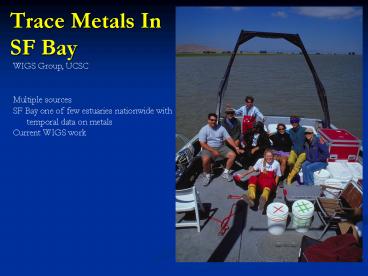Trace Metals In SF Bay PowerPoint PPT Presentation
1 / 22
Title: Trace Metals In SF Bay
1
Trace Metals In SF Bay
WIGS Group, UCSC
- Multiple sources
- SF Bay one of few estuaries nationwide with
temporal data on metals - Current WIGS work
2
Complexity of Metal Inputs to SF Bay (Flegal et
al, 2005)
- 1) POTWs and industrial inputs
- 2) Diagenetic Remobilization Ag, Co, Ni, Cu, Zn.
(Flegal et al., 1996 Rivera-Duarte and Flegal,
1997) - 3) Urban Runoff vs Fluvial Inputs
- 4) Atmospheric deposition (Conaway et al., 2005)
- 5) Historic Gold Mining (Conaway et al., 2004)
3
- The lack of peer-reviewed scientific reports
on current levels of contaminants in those waters
over (the past 30 years) precludes statistically
valid measures of changes in contaminant levels
over the past decade. One exception is the San
Francisco Bay Regional Monitoring Program.
4
Temporal trends in wastewater source loadings of
Ag and Pb (Squire et al., 2002)
930 tonnes of trace metals released from POTW of
the estuary in 1960, reduced to just 46 tonnes in
1999
Black South Bay and Gray North Bay
- Clean water Act of 1972
- Closure of a photograph processing plant located
in the southern reach in the mid 1980s - San Franciscos Oceanside Water Pollution Control
Plant rerouted 12 of the total effluent to the
Pacific ocean via a 4.5 mile ocean outfall.
5
Pb Isotopes in SF Bay Water (Steding et al., 2000)
- Dissolved Pb has not decreased in South Bay
- Dissolved Pb is largely composed of 1960-1970s
gasoline
6
CurrentWIGS Work
- Methods development (Ndungu et al., 2005)
- Effects of Hg on salmonids (Mary)
- Hg cycling (Kit)
- Mercury speciation and complexation (Frank)
- Phytoplankton blooms and metals (Allison)
7
Pronounced Variations in Nutrients and Trace
Metals During a Spring Phytoplankton Bloom in San
Francisco Bay
- Allison C. Luengen A. Russell Flegal
- University of California, Santa Cruz
- Summary
- Complexation prevents copper uptake, but not
nickel uptake - Bloom decay important for metal cycling
- Pb cycling during bloom
8
South SF Bay Characteristics
- Predictable phytoplankton bloom in South Bay
occurs when water column stratifies in spring
(Cloern, 1996) - The phytoplankton bloom depletes nutrients and
some trace metals (Beck et al., 2002 Grenz et
al., 2000 Luoma et al., 1998)
- Metals such as copper are
organically complexed, limiting their
bioavailability (Buck and Bruland, 2005 Donat et
al., 1994 Sunda and Huntsman, 1998)
9
Objectives
- Characterize the biogeochemistry of Co, Cu, Ni,
Pb, and Zn during a spring bloom - Assess bioavailability of Ni
- Effect of bloom decay
- Use Principle Components Analysis (PCA) to reduce
the data into three factors
10
Rise and Decay of a Bloom
11
Nutrients During Bloom Diagnostic nutrient
cycles
Nutrient analyses by Steve Hager, USGS
12
Principal Component Analyses
13
Dissolved Cu Ni During BloomSpeciation
determines uptake
14
Dissolved Ni Uptake by Phytoplankton
- Ni significantly (plt0.00) depleted during bloom
- Ni significantly (plt0.00) affected by station
15
Nickel Is Bioavailable
- Uptake of Ni consistent with Luoma et al. (1998)
field study but different from Beck et al. (2002)
lab study.
- Why is Ni bioavailable? (Sedlak et al., 1997)
- Degradation of EDTA-Ni
- Seasonal changes in EDTA-Ni complexation
16
Dissolved Mn Co During Bloom Inversely
related to bloom
Roitz et al. (2002) found remobilization of Mn
from sediment following a bloom
17
Dissolved Co Scavenging Decay
- Increase in dissolved Co during bloom decay NOT
due to sediment-water repartitioning - Kd controlled by station in the reduced model
(p0.00024)
18
Dissolved Zn Scavenging Decay
- Scavenging and bloom decay do significantly
(p0.036 0.032, respectively) affect Kd
19
Dissolved Pb During Bloom Multiple linear
regression to assess contribution of individual
factors
20
Pb Rise, Scavenging, Decay
21
Conclusions
- Speciation prevents dissolved Cu uptake, but not
dissolved Ni uptake - Decay of the bloom is important for dissolved Mn,
Co, Zn - Pb cycling is affected by rise, scavenging, decay
22
Acknowledgements
USGS Jim Cloern, Scott Conard, Steve Hager, Amy
Little, Cary Lopez, Tara Schraga, and Byron
Richards
- calculation
WIGS Frank Black, Kit Conaway, J.R. Flanders,
Mari Gilmore, Ana Gonzalez, Sharon Hibdon, Brian
Johnson, Fiona Morris, Charley Rankin, Mara
Ranville, Genine Scelfo, Hans Schwing
COMMITTEE Ken Bruland, Raphael
Kudela, Sam Luoma
ANALYTICAL Rob Franks STATISTICS Pete
Raimondi
FUNDING ETOX Dept, UC Toxics, RMP, C.DELSI

